
Hello and welcome to the fourth edition of Linux++, a weekly dive into the major topics, events, and headlines throughout the Linux world. This issue covers the week starting Monday, February 10, 2020 and ending Sunday, February 16, 2020.
This is not meant to be a deep dive into the different topics, but more like a curated selection of what I find most interesting each week with links provided to delve into the material as much as your heart desires.
If you missed the last report, Issue 3 from February 9, 2020, you can find it here. You can also find all of the issues posted on the official Linux++ Twitter account here or follow the Linux++ publication on Front Page Linux here.
In addition, there is a Telegram group dedicated to the readers and anyone else interested in discussion about the newest updates in the GNU/Linux world available to join here.
NOTE: Peppermint OS is currently looking for a maintainer(s) to help out with the distribution in the wake of Mark Greaves unfortunate passing. From the words of Kendall Weaver (co-founder of the distribution):
So, if you have the ability to help, it could dramatically change the lives of many passionate users in the Peppermint community after such a trying time. If you would like to help out with the project, you can join the Peppermint OS forums here and contact Kendall through a direct message. Thank you!
There is a lot to cover so let’s dive right in!
Personal News
If you don’t care what I’ve been up to over the past week, feel free to skip ahead to the Community News section 🙂
GNOME 3: A Journey Like No Other
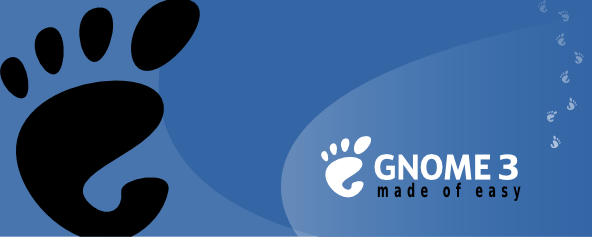
I have just released an article entitled “GNOME 3: A Journey Like No Other”, which details GNOME’s difficult road through the transition from version 2 to 3. It also goes into my thoughts on the GNOME project as it stands today with the myriad of options available to users of GNU/Linux.
This was mostly written due to my exploration of Intel’s Clear Linux* in the last issue where I had used GNOME 3 for the first time in quite a while and found it in much better shape than it was previously. Somehow, finally, GNOME 3 has clicked for me and I totally get it. I am now running Solus 4.1 GNOME on my Intel NUC and have been using it more and more as the days go by. Great job, GNOME team!
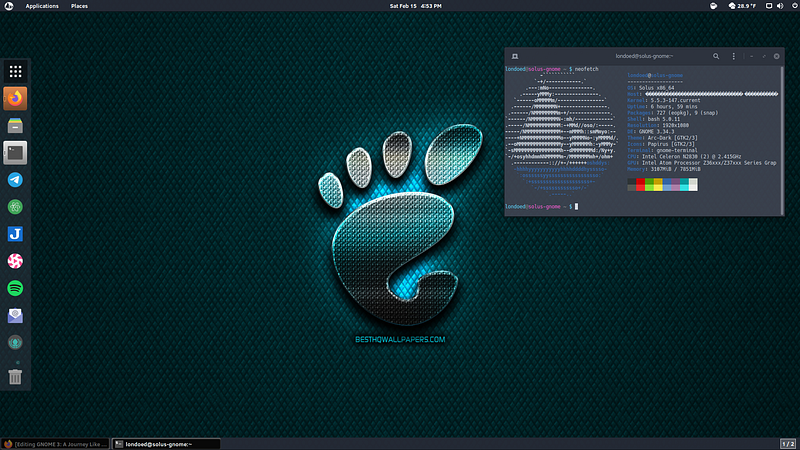
If you would like to check out that article, you can find it here.
Community News
The WireGuard Craze

Even before Linux kernel 5.5 was officially released, many Linux enthusiasts already had their sights set on the future 5.6 release, and for good reason. The main draw: WireGuard is being merged into the mainline Linux kernel.
So, why are Linux users going crazy over WireGuard anyways? Well, if you have ever had experience with popular VPNs in the past such as OpenVPN or IPsec, then you may want to pay attention!
WireGuard is branded as an easy to configure, fast, and extremely secure open-source Virtual Private Network (VPN) that uses the most advanced cryptographic algorithms (ciphers) of our time. It was created by Jason Donenfeld, a well-known security researcher who also happens to work on the Linux kernel, to provide a much simpler, more lightweight, and more secure VPN that could be run on any machine, including single-board computers (like the Raspberry Pi). Although WireGuard was originally targeted at Linux, it has grown into a cross-platform VPN solution that is available on Windows, macOS, BSD, iOS, and Android.
The aforementioned competing VPNs were developed a long time ago and though they provide all the functionality you could want, they are not necessarily easy to setup or maintain. WireGuard is so simple to configure, it is literally as easy as setting up SSH (Secure Shell). The WireGuard setup guide is incredibly simple compared to other open-source VPN providers.
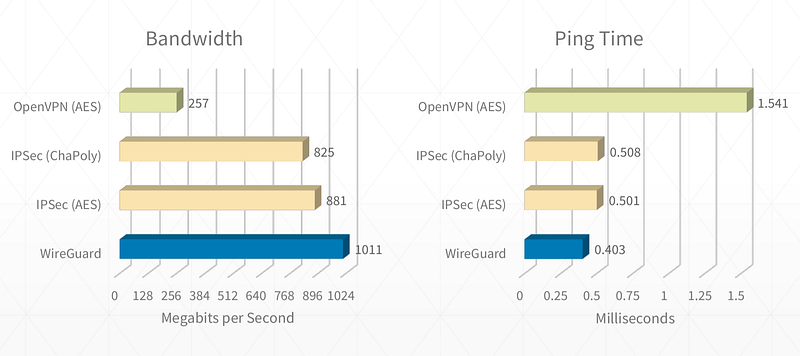
Moreover, WireGuard supports the most advanced cryptography that we have today including Noise protocol framework, Curve25519, ChaCha20, Poly1305, BLAKE2, SipHash24, HKDF, and secure trusted connections.
So, now you may be wondering: if WireGuard is already available and easy to get running on a Linux system, why is everyone making such a big fuss about it being integrated into the kernel?
WireGuard works a bit differently than most of the applications you probably use. It is what is known as a kernel module. This means that when you configure it, you are actually modifying your kernel. Most applications that you install on your computer are found in what is called the user-space, or basically run on top of the kernel itself, abstracted away from the lower-level processes of the machine.
Living in kernel-space is part of the reason that WireGuard is so much faster and lightweight than the other open-source VPN options out there because it can directly communicate and interact with the hardware on your system without those extra layers of abstraction.

Consequently, including WireGuard in the Linux kernel itself will allow it to work much more efficiently on any Linux distribution and any hardware configuration. The added benefit is that adoption of WireGuard as the VPN of choice will likely increase significantly, possibly causing a massive overhaul in the current VPN market. Hopefully, open-source will push for innovation and everyone will win once again!
Ubuntu 18.04.4 LTS: Newest Point Release Out Now

In the shadow of the much-anticipated 20.04 LTS release later this spring, Ubuntu and it’s flavors have released their final ISO images for the 18.04.4 release, the next iteration of the popular LTS release that arrived in April 2018.
After a week delay, 18.04.4 is now available for upgrade with a few enhancements. Though point releases for LTS don’t often include any earth-shattering changes, it does bring with it all of the OS fixes since the last ISO was released. Some of the changes include installer fixes, better window manager support, and some Snap updates in the GNOME Inital Setup tool.

In addition to the release of Ubuntu 18.04.4 LTS is the HWE (hardware enablement stack) release. This release brings a newer Linux kernel (5.3) that is backported from Ubuntu 19.10, upgrade support for graphics drivers, and a newer display server.
If you installed Ubuntu 18.04 LTS using a point release then you should get the new HWE with a regular system upgrade. However, if you installed it with the original 18.04 LTS release, then you can enable the installation of HWE using the following command:
~$ sudo apt install --install-recommends linux-generic-hwe-18.04 xserver-xorg-hwe-18.04
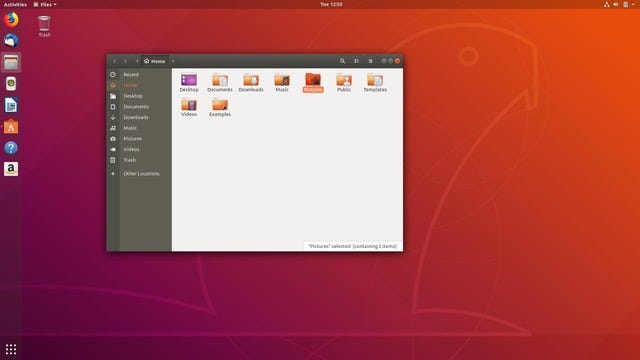
To read the official Ubuntu release notes, you can find them here. If you would like to download the Ubuntu 18.04.4 LTS release, you can find the images here.
KDE Plasma 5.18 LTS is Here!

The wonderful developers at KDE have finally pushed their Plasma Desktop version 5.18 LTS to official status and it is available to try out in all its glory now. This release is special because it is “Long Term Support”, which means that it will continue to receive updates and improvements from the KDE team for 2 years, whereas other releases are only supported for 4 months.
This substantial release brings with it some new functionalities as well as improvements to the overall design of Plasma. The first highlighted area is the new, fun “Emoji Selector” tool that can easily be accessed anywhere by pressing “Super + .”. It can also be found under Utilities in the Plasma menu. The tool that is brought up will allow you to paste any emoji available wherever you feel some added emotion is needed.
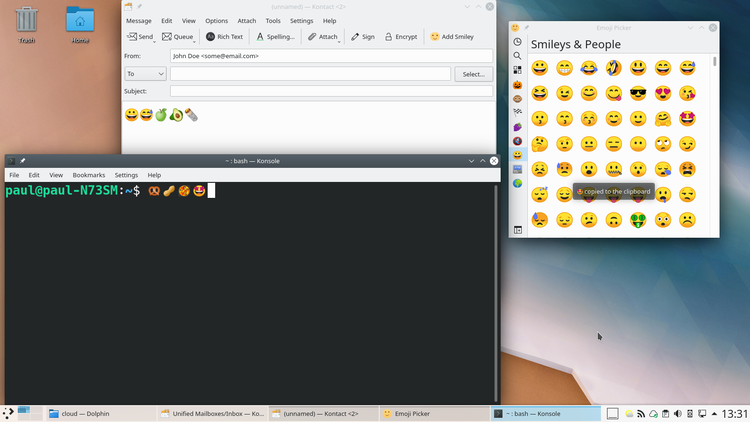
In addition, the Plasma developers have removed the “Desktop Toolbox” hamburger menu that was placed awkwardly in the right corner of the desktop. Instead, they have created a Global Edit mode that provides similar functionality as the previous tool, but can be easliy accessed by left-clicking anywhere on the desktop and choosing the “Customize layout” option. A Global Edit Bar will appear at the top of your screen with the ability to access widgets, activities, and desktop configuration settings. I’m sure that this is a welcome functionality as the old hamburger menu was not well-liked within the Plasma community.
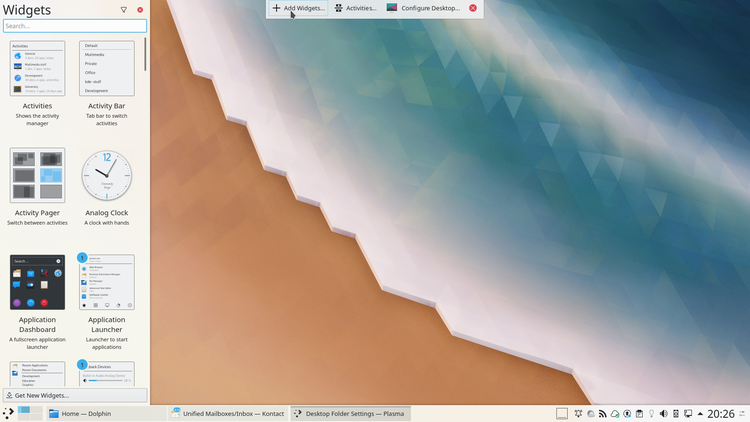
Another major improvement involves Plasma’s interaction with GTK+ applications, a sore spot for the KDE team in the past. With this release, there is now increased support for the client-side decorations found in GTK applications. They now inherit Plasma’s settings for fonts, icons, mouse cursors as well as show proper shadowing and resize areas. This is a great improvement, as I always found it weird and annoying that my cursor would change every time I hovered over a GTK app. It is a nice touch that all these settings are now bundled and will give Plasma much more continuity in the look and feel department. Great job, Plasma team!
There are quite a few more improvements that come with the newest LTS release including a new “Night Color Control” system tray widget, a more compact design for the “Audio Volume System” widget, a multitude of improvements to the notification system, upgraded look and functionality of the “System Settings” tool, improvements to the Discover software center and much more.
If you would like to read about all of the new offerings in Plasma Desktop 5.18, you can find the official announcement from KDE here.
If you would like to try out KDE Plasma 5.18, it is already available in KDE neon and can be utilized in Kubuntu 19.10 via these commands:
# Add Kubuntu Backports PPA #
sudo apt-add-repository ppa:kubuntu-ppa/backports
# Install Plasma 5.18 #
sudo apt update && sudo apt full-upgrade
MX Linux 19.1 Updates

MX Linux has skyrocketed in popularity over the last year or so and now has a mature and faithful community of users (and rightfully so!). The 19.0 release was an impressive update to say the least and certainly has grabbed the Linux world by storm. There are many reasons for this explosion including MX’s incredible custom toolset, the wonderful and easy to use desktop layout, the pure speed of it, even on older hardware, stability, and the fact that the developers are extremely involved in the greater Linux community and truly listen to what their users desire.
This week, a new point release was made available for MX users to download or upgrade to and it includes an ISO refresh with some pretty nice updates from their own repository as well as Debian 10.3 “Buster”, which the distribution is based off of.

One aspect that was highlighted by the developers in the release notes is that they are producing a third ISO with AHS (Advanced Hardware Support) included for users with newer hardware configurations. The AHS ISO is 64-bit and ships with the 5.4 kernel, Mesa 19.2, updated xserver drivers, and some recompiled applications that will utilize a newer graphic profile. This is not the creation of the AHS repository, just the first time that it is offered on an ISO out-of-the-box.
In addition, the newest ISOs are built without the antiX repository enabled. You can find out more about why that is here.
The normal non-AHS ISO ships with the latest software available in the Debian 10.3 stable repository including Linux kernel 4.19, Mesa 18.3.6, GIMP 2.10.12, Firefox 73, LibreOffice 6.1.5 (with 6.4 available in the MX repositories), and quite a bit more.
Moreover, a few of MX’s own applications have received updates including mx-installer, mx-packageinstaller, mx-tweak, brightness-systray, and mx-pkexec. Definitely a solid amount of MX tools received the treatment, which I’m sure MX users are eager to try out.
If that wasn’t enough for you, an alternate window manager, Fluxbox, is available on the ISOs and can be reached via the session chooser on the login screen.
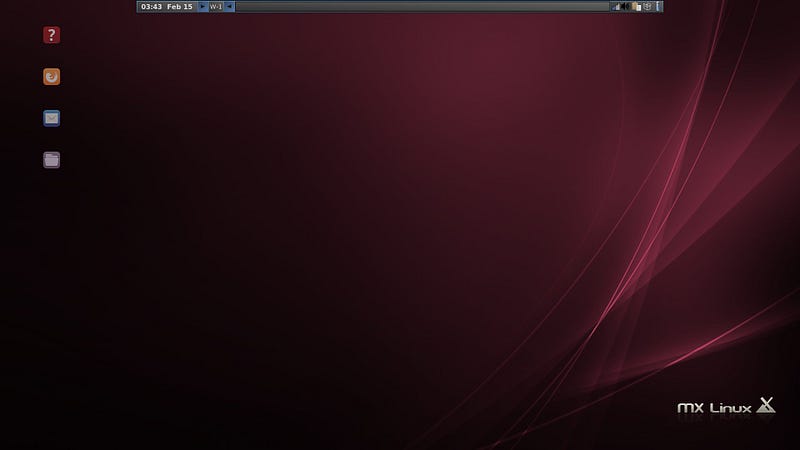
So congrats, MX Team, on what looks to be a very promising release!
MATE Desktop 1.24 Released

Though MATE began as a simple fork of the old GNOME 2 codebase, through the years it has grown in popularity to become so much more than just a continuation of old ideals. After nearly a year of development, the MATE team has finally released their next iteration, 1.24, with quite a bit of goodies for fans of the lightweight, yet full-featured desktop environment.

There are so many new features, bug fixes, and general improvements, that it would be impossible to list them all in the Linux++ format, but I will list some of the most interesting to me below:
- Eye of MATE (the native image viewing application) has been improved with support for Wayland and embedded color profiles.
- The System Monitor panel applet has received support for NVMe drives.
- The Control Center has been fixed to display icons correctly on HiDPI displays.
- A new Time and Date Manager application has be implemented.
- Do-Not-Disturb functionality has been added to the notification daemon.
- Marco (the default window manager) has received many notable changes, bug fixes and functionality improvements.
- A brand new tool, called the MATE Disk Image Mounter has been added.
- The MATE Panel has had a number of bug fixes related to it crashing when changing layouts as well as improved support for Wayland compatibility.
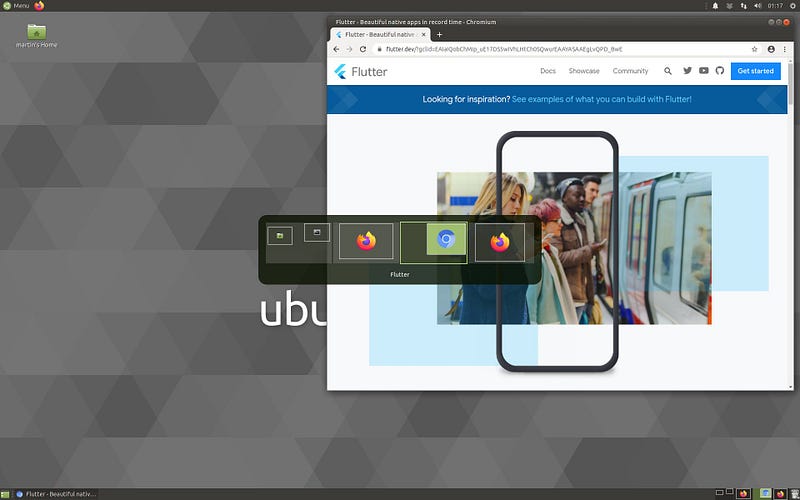
There is so much more to be found in the official MATE release notes, which you can check out here.
If you are using Ubuntu MATE, you might have already seen some of these changes take effect, as the team has back-ported many of them to MATE 1.22 which makes them available in Ubuntu MATE 19.10.
Most rolling release distributions like Arch, Manjaro, and Solus will likely have these upgrades available as soon as possible. Otherwise, Ubuntu MATE 20.04 LTS is confirmed to release with MATE 1.24 in April. So, not much longer to wait!

Personally, I think these new changes are terrific and just show how well the MATE team is tuned in to what they need to work on and are getting it done with style. So, congrats on a really nice release, MATE team!
Here is a recently posted video review by Linux & Projects on YouTube of MATE 1.24 if you’re interested in checking out the new features in action:
Onward to GTK 4.0!

In a blog post by the GTK developers, the release of GTK 3.98 was announced and although it was slightly behind schedule and didn’t cram as much into it as had been desired, it is still a major step towards GTK 4.0.
For those not in the know, GTK is the toolkit behind the GNOME (and it’s related) desktop environment(s) and applications. It is written in the C language, however, many language bindings have been created for simpler languages like Python and Ruby, as well as support for Vala, GNOME’s in-house language specifically tailored towards GTK development. It also uses a special JavaScript engine for client-side decorations (or now even complete application development!).
Two competing graphical user interface toolkits, GTK and Qt (C++ based), are at the heart of nearly all Linux distributions. Other popular GTK desktop environments include XFCE, Cinnamon, MATE, Budgie, and Pantheon. KDE is a Qt project and there have been quite a few more desktop environments that have adopted the Qt toolkit recently like Deepin, LXQT, and UKUI.

However, this move toward GTK 4.0 is exciting and should be highly praised by those in the GNOME community. There are a ton of upgrades, but some that were highlighted by the development team are critical and interesting:
- Performance: The GL renderer has seen many optimization and performance enhancements due to the Westcoast hackfest last year. Improving the CSS machinery has been a major focus for this release, where the CSS lookups are using a Bloom filter now and the IO for icon loading has been moved to a thread. This performance boost came on the heels of the sysprof profiling support that has been added.
- DND: The refactoring of DND is finished. The GTK API has been turned into event controllers and support for file transfers through the transfer portal has been added for both DND and the clipboard.
- GDK: Continued compatibility with Wayland is in the works, but has not been completed. Some changes to the API have been made and XI2 is now mandatory when building the X11 backend. The Wayland backend no longer requires libwayland-cursor to load the cursor themes, which can now be loaded on demand.
- GTK: Several classes have been made explicitly non-subclassalbe, simplifying the widget hierarchy by forcing widgets to derive from GtkWidget wherever possible. The GtkNative (split from GtkRoot) interface has been built for widgets that have their own surface. A contraint-based layout manager has been added, which needs testing from the community.

There are many more improvements added to the GTK toolbox, however, the GTK developers also are focusing on what is ahead. Here is the list of items in the hopper directly from the update posting:
- Event controllers for keyboard shortcuts
- Movable popovers
- Row-recylcing list and grid views
- Revamped accessibility infrastructure
- Animation API
This is an exciting time for GTK developers and moves the needle even closer for the eventual work on GNOME 4!
If you would like to check out the official update from the GTK Development Blog, you can find it here.
Ubuntu Podcast Returning for Season 13
The Linux podcasting scene has absolutely exploded in that last few years, that much cannot be argued. I personally have at least 15 different Linux podcasts that I follow regularly, which helps me get through the workday. However, there is one podcast that I look forward to each year that it is announced to be returning: Ubuntu Podcast.

Possibly because it was the first podcast I ever listened to or the fact that I used Ubuntu pretty much faithfully for over a decade, I always cheer when I see the announcement of it’s continuation.
One of the longest running Linux podcasts, Ubuntu Podcast has a fun little quip that they do at the end of each season where they act as if the season’s final episodes are going to possibly be the last ones ever. So, every offseason, fans are left wondering if they really had heard the last episode of the podcast for good. Of course, there is always the possibility that the show won’t go on, but not this year, thankfully!
Last Sunday, the crew behind Ubuntu Podcast sent out a tweet letting everyone know that they’ll be around for a new season this year. Good on you, fellas!

Though the podcast has had a rotating cast of characters over the years, it appears the three main staples of late, Alan Pope, Martin Wimpress, and Mark Johnson are back at it and having just as much fun as always. This season should be a particularly interesting one considering the (so far) highly-praised Ubuntu 20.04 LTS release is arriving in a few short months, which will be the first release with Martin at the helm of the desktop team at Canonical.
No matter what happens, we know that at least they will be able to laugh about it on the podcast and likely that laughter will be contagious.
Can’t wait to see (or hear?) you guys back at it!
Deep Dive with Uri Herrera of Nitrux OS
Uri Herrera may be most well-known for his involvement in the incredibly unique Nitrux OS project, but he has also done a lot of other important work within the KDE community. A designer by nature, programmer by necessity, Uri is behind many of your favorite themes available in KDE Plasma as well as the creator of it’s default themes, Breeze and Breeze Dark.

Last week, he was featured on the Linux Spotlight show (Episode 36) for an in depth interview with the host of Big Daddy Linux Live!, Rocco. The hour long interview moves from Uri’s beginnings with computers, Linux and design to his involvement with KDE, Nitrux OS and beyond. It is an extremely interesting insight into one of Linux’s most creative minds and I think you will really enjoy what he has to say.
The Linux Spotlight interview is available on all major podcasting platforms, but you can find the YouTube link below:
Community Voice: Michael Mikowski

This week we welcome Michael Mikowski, a long-time user of KDE and Kubuntu. Now, he is the team lead of the Kubuntu Focus project, a high-powered laptop that comes with an optimized version of Kubuntu to create a truly incredible machine for any workflow. I’m happy to present my interview with Michael below:
How would you describe Linux to someone who is unfamiliar with it, but interested?
“Today, everything except the desktop runs Linux — Supercomputers, DVRs, Refrigerators, routers, NAS, etc. And if you work in certain fields, such as DevOps, Deep Learning, AI, Cloud and Web Development, Media, and others, you really should consider using Linux as your primary OS. The reason is everything you create will be deployed on Linux, so almost any automation you create can be easily transferred and scaled to your deployment. That’s powerful”
What got you hooked on the Linux operating system and why do you continue to use it?
“I was using Unix back in the mid-90s when running CAE-like fluid flow analysis on my company-issued HP-735. Compared to the Windows and macOS systems at the time, it was massively superior in virtually every aspect. Back then, we were running remote X sessions with local hardware, accelerated 3D graphics, and slicing through animated assemblies in real time. Other systems still don’t provide that kind of flexibility!

A few years later, I had a design and engineering consultancy company in Dearborn, Michigan and we bought a system with Windows NT ‘professionally’ installed from Aztec Computers, which means it didn’t work. So, I spent 90 hours reinstalling, going through DLL hell, shuffling driver CDs, and the like. Finally, I gave RedHat a go. In two hours we had the server we wanted and we never went back.
While I’ve had a few Windows computers and some virtual machines (e.g. to run QuickBooks Pro), it’s never been my primary desktop. That’s been either Unix or Linux since 1993.”
What is your absolute favorite aspect about being part of this community?
“It is based on merit and value. Linux became popular because it’s really, really good at many different things. Linux didn’t have a daddy write a EULA for it, or a mommy sell it to a VP of IBM. It had to grow based on how good it is. Today, virtually all systems outside of desktops run on Linux because it’s adaptable and there is no ‘licensing professional’ who’s going to try to shake you down for $100k every six months. You might not remember BSA, but these guys were like tort lawyers chasing after ambulances.”
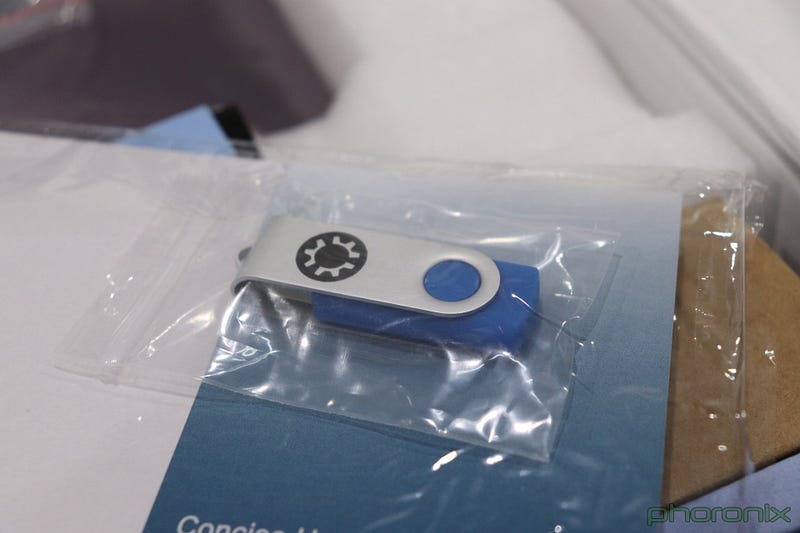
Do you prefer a distribution(s) (or family of distributions) that you find yourself being drawn to most and why? Do you prefer a particular desktop environment(s) for your workflow and why?
“I prefer Ubuntu-based systems these days. I started with RedHat in 1998, got a RHCE certification in 2004, ran some pretty hefty RHEL clusters for a number of years, and then switched to Kubuntu around 2008. I think Red Hat hurt themselves getting out of the desktop because it’s the gateway product for developers. A great parallel is how Ford recently stopped selling cars in the U.S. That’s just stupid. Now, instead of a kid picking up an awesome Focus RS for their first car, they’re going to pick up a different brand and stick with that. People don’t like to change brands because it requires them to admit they’ve made a mistake. This is especially powerful when your customers are narcissistic.

Our research shows that something like 70% of Amazon containers are Debian-based. It’s not because Ubuntu or Amazon Linux are technically superior to RHEL, but they are superior in that people don’t want to learn an additional system, and RPM systems are substantially different. Something like 85% of first time users of Linux pick up some version of Ubuntu or Debian. And when they move to bigger deployments, they keep using what they know until it doesn’t work anymore — which rarely happens. [Mark] Shuttleworth complains that there is no money in Linux desktops, but he wouldn’t have all those server systems if it weren’t for his emphasis and execution on Ubuntu. Good on ya, Mark!
As for desktops, I’ve used mostly KDE since before it’s 1.0 release. It was so much better than the alternatives for many years, but then it had a really rough patch between versions 4 and 5. But, over the last decade it’s become pretty incredible. It is now much lighter than GNOME and even LXDE in some scenarios. It’s also polished, fast, and relatively bug free. It’s a great tool kit for creating beautiful computing experiences, whether that’s a kiosk or a desktop environment.”

What is one FOSS project that you are interested in or currently following to watch grow and see the direction it moves in?
“Well, I have a bunch of FOSS projects in JavaScript like HiScore and PowerCSS. Do those count?”
What do you think it would take for the Linux desktop to make it into the mainstream and compete with Windows and macOS?
“I think this is happening now with the Kubuntu Focus. The OS and even the applications have been sufficient for many desktop purposes. For example, my parents have been using Linux for 20 years. What’s been holding it back is really support. There are a few vendors that are close, but we think the Focus really brings support to the level you could give this to your grandparents and have them happily using within a few minutes.”
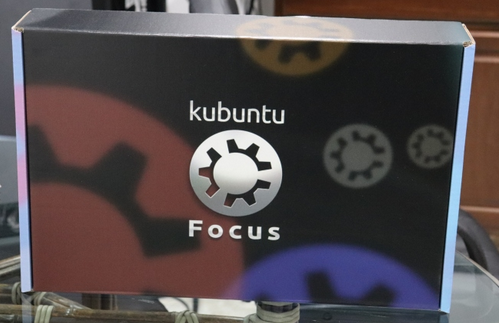
What do you think the short-term and long-term future of Linux holds?
“Linux will continue to evolve while maintaining the UNIX ethos. I believe it has reached the tipping point where people will value the convenience of a single Linux system over constantly context switching between their server OS and their desktop OS.”
How did the Kubuntu Focus project come to be? In your opinion, what is the main feature(s) that set(s) the Kubuntu Focus apart from other similarly priced computers?
“I have worked as a Senior Software Architect and Product Developer in Silicon Valley for over a decade and have been surrounded by developers using MacBook Pros for jobs where they really should be using Linux. The amount of time these developers spent messing around with HomeBrew and the like to create a Linux-like environment was insane. I wrote a lot of automation scripts for these environments and, invariably, I had to spend days porting them to the ancient Bash Shell (from 2009) and BSD tools just to support developers who insisted on running an OS that will never be used for deployment.

On the other hand, I understand why these developers actually wanted MBPs. They are well-built, they have a long battery life, and there’s the trophy status. Then there’s the promise of ‘just works’, which is true for some things. On the other hand, they are enormously expensive, have horribly slow and inefficient GPUs without CUDA and cuDNN, and are highly problematic when working with Linux deployment environments. The reality is what a lot of code developers run on their Macs run far better with far less trouble on an Ubuntu-based system.
I was in-between gigs and felt that now might be a great time to launch an alternative to the MBP for enterprise environments. We wanted to ensure the following:
- The best out-of-the-box user experience regardless of OS. The laptop would focus on key enterprise workflows such as cloud development, database administration, DevOps with AWS/Azure/Google, deep learning, enterprise security, image editing, gaming, professional photography, video editing, and web application development.
- Provide a level of hardware integration previously not found from any Linux hardware vendor. While it didn’t make sense to invest in a fully custom solution, we did spend many man months tuning the hardware to the OS in a much more complete way than individual users have time for.
- Highly reliable, secure, and enterprise ready. Enterprises and academia can purchase with confidence.
- Identify, create, test, and integrate key workflows needed by our customers. This is critical to provide the best out-of-the-box user experience, customer satisfaction, and user success.
We approached the Kubuntu Council, Canonical, KDE, and Tuxedo Computers and built a team. I won’t get into the details, but we’ve really had fantastic involvement from everyone and, in my opinion, we are producing a much better product than we would have created alone.

Kubuntu is oh-so-close to more-than-good-enough to replace MBPs, but there are some serious issues that had to be worked out for the hardware. For example, we found under some circumstances that the CPU ran far too hot and Intel p-state was not working correctly, so we fixed that. The keyboard LED’s needed to work. We needed a Kubuntu meta key. Battery life was initially poor, so we found solutions to more than double that. We optimized the browser to use full GPU acceleration, added the hints system, optimized the desktop for the laptop screen, and integrated our online Workflows and Apps support pages.

The Kubuntu Focus starts at $1,795. In it’s base configuration, it is very competitive with models from other boutique vendors of Windows and Linux systems. One can buy just the hardware for maybe $130 less, but that’s a bare-bones Windows model with no Linux optimization or support. So, the question for our customers is this: Do you want to spend weeks or months doing your own research and optimization, or do you want a device that just works for around $100 more and also contribute back to Kubuntu and KDE?
If you’re an AI developer, you really need to take a good look at the Focus. It can be 2–8x faster than a MBP at deep learning and we have the full suite of Jupyter Notebook, Keras, MXNet, PyTorch, TensorFlow, and Theano in Anaconda containers. Just power on, install a few cuDNN packages from the vendor, and start running GPU-accelerated models. It’s that simple.
Notice we don’t consider existing Linux desktop users as our target demographic, although they are certainly in the mix. We’re trying to attract other OS users who are contemplating moving to Linux full-time. And we think we’ve got the secret sauce for these people. As of this writing, nearly half our customers are from this group. That’s a fantastic response.”
If you’re able to talk about it, are there any plans for different models featuring Kubuntu as the flagship?
“Absolutely! But, we won’t add models rapidly. We want to take the same care with development as we have the Focus to ensure out-of-the-box experience and value. That means each model will need to be vetted for key features desired by our customers.
The Kubuntu Focus is the stock 18.04.3 LTS and then augmented with repository packages. These are upgraded through the normal APT process. These packages are currently named kfocus-<modelID>-<purpose>-x.x.x_amd64.deb. We will add new model packages when new hardware is available.”
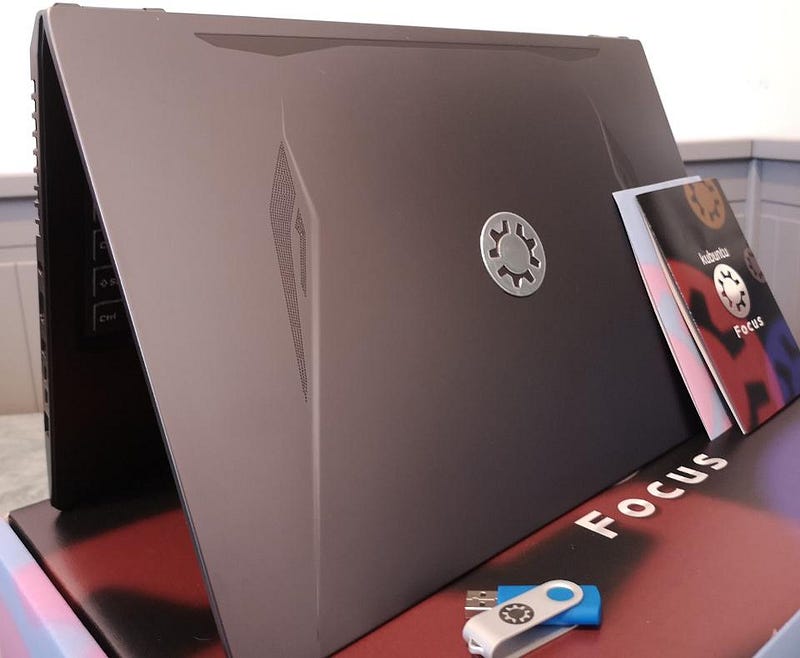
If you’re able to talk about it, are there any new ideas or features being planned for the future generations of the Focus?
“We are very excited about [Kubuntu] 20.04 LTS. KDE has improved a lot in just the last 6 months and we feel this Kubuntu release will be an absolute winner. We are busy testing on the platform and are working to identify and resolve any issues on the hardware.
Be assured, we will not be designing our own laptop hardware any time soon as that is insanely expensive and time consuming. Instead, we are working with ODMs for the near future. We would like to offer an all-AMD laptop if we can find a model that meets all our UX requirements.
We have more design options available with desktop and SFF systems, but we haven’t explored those markets yet.”

Do you have any major goals that you would love to achieve in the near future related to your involvement with the Linux community?
“We would love to be recognized as the go-to, just-works, out-of-the-box solution for professionals who want to get things done. We also want to provide workflows that are valuable to all Linux users, not just those who focus on hardware. A good parallel might be the Arch user forum. We don’t use Arch, but thanks to their forums, we were able to solve a lot of hardware challenges. We hope Arch users feel the same way about our workflows.”
I would like to thank Michael for joining Linux++ this week and giving us a sneak peak into what drives the Kubuntu Focus team. I really do believe that this is an incredible product with a ton of time and effort put into it and has the potential to become something really great for new and experienced users alike.
If you would like to order a Kubuntu Focus for yourself or just check it out, you can find all the information you need at their homepage here.
Linux Desktop Setup of the Week
This week’s selection was presented by u/Better_feed_Malphite and the post was titled [DWM] Monokai, Suckless and Vim setup. Here is the screenshot that they posted:

And here are the system details:
OS: Arch Linux
WM: dwm
Shell: zsh
Theme: Materia-dark-compact [GTK 3]
Icons: Papirus-Dark [GTK 3]
Wallpaper: Custom Wallpaper from imgur.com
Thanks, u/Better_feed_Malphite, for a unique and colorful desktop!
If you would like to browse, discover, and comment on some interesting, unique, and just plain awesome Linux desktop customization, check out r/unixporn on Reddit!
See You Next Week!
I hope you enjoyed reading about the on-goings of the Linux community this week. Feel free to start up a lengthy discussion, give me some feedback on what you like about Linux++ and what doesn’t work so well, or just say hello in the comments below.
In addition, you can follow the Linux++ account on Twitter at @linux_plus_plus, join us on Telegram here, or send email to linuxplusplus@protonmail.com if you have any news or feedback that you would like to share with me.
Thanks so much for reading, have a wonderful week, and long live GNU/Linux!

Be the first to comment at forum.tuxdigital.com